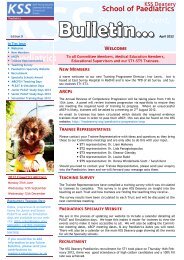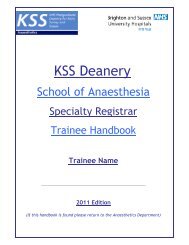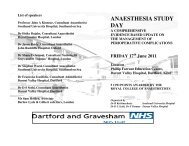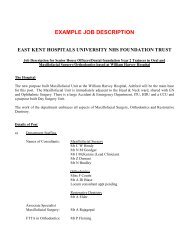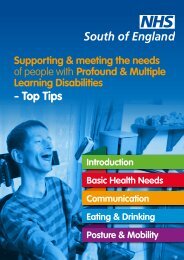Pharmacology of inotropes and vasopressors - KSS Deanery
Pharmacology of inotropes and vasopressors - KSS Deanery
Pharmacology of inotropes and vasopressors - KSS Deanery
- No tags were found...
Create successful ePaper yourself
Turn your PDF publications into a flip-book with our unique Google optimized e-Paper software.
<strong>Pharmacology</strong> <strong>of</strong> <strong>inotropes</strong><strong>and</strong> <strong>vasopressors</strong>
Curriculum3.3 Recognises <strong>and</strong> manages the patient with circulatory failure4.4 Uses fluids <strong>and</strong> vasoactive / inotropic drugs to support thecirculationPR_BK_41 Drugs <strong>and</strong> the sympathetic nervous system: adrenergicreceptors <strong>and</strong> molecular mechanisms <strong>of</strong> action: Indications forpharmacological use <strong>of</strong> naturally occurring catecholamines <strong>and</strong>synthetic analogues.PR_BK_43 Cardiovascular system: general: drug effects on theheart [inotropy <strong>and</strong> chronotropy] <strong>and</strong> on the circulation: arterial <strong>and</strong>venous effects; systemic <strong>and</strong> pulmonary effectsPR_BK_44 Inotropes <strong>and</strong> pressors: Classification; site <strong>of</strong> action.Synthetic <strong>inotropes</strong> compared with adrenalinePB_BK_38 Cardiac muscle contraction
Definitions Inotrope: increases cardiac output byincreasing velocity <strong>and</strong> force <strong>of</strong> myocardialcontraction Vasopressor: causes contraction <strong>of</strong> arteriolar<strong>and</strong> venous smooth muscle Inodilator: increases cardiac output by acombination <strong>of</strong> inotropic <strong>and</strong> vasodilator effects
Mechanisms <strong>of</strong> drug action Sympathomimeticsα-agonistsβ-agonistsDopamine agonists (D 1 -like, D 2 -like)Phosphodiesterase inhibitors (PDE 3) OthersVasopressin (V 1 )LevosimendanCardiac glycosides
α-agonistsα 1 receptors: vascular smooth muscle contraction
β-agonistsβ 1 (β 2 ) Inotropy ( force) Chronotropy ( rate) Dromotropy (conduction)β 2 Vasodilatation
Phosphodiesterase 3 inhibitors Heart <strong>and</strong> vascularsmooth muscle Inodilators Lusitropic (improveddiastolic relaxation)
Vasopressin (AVP, ADH) Hypothalamic nonapeptidehormone , released fromposterior pituitary V 1 receptor agonist - potentarterial vasoconstrictor V 2 receptors in renal collectingduct – water reabsorption
Levosimendan Calcium sensitiser - ↑ sensitivity <strong>of</strong> contractileproteins to Ca 2+ without ↑ intracellular Ca 2+ Inotropic <strong>and</strong> chronotropic effects Independent <strong>of</strong> adrenoceptors <strong>and</strong> cAMP Vasodilator: opens ATP-sensitive K + channels onvascular smooth muscle
Cardiac glycosides: digoxinInhibits Na + /K + pump in myocardial cell membrane→ intracellular Na +→ intracellular Ca 2+ (Na + :Ca 2+ exchanger)→ force <strong>of</strong> contraction
Synthetic CatecholaminesIsoprenalineDobutamineDopexamine
Agentβ 1effects β 2effects α effects DA effectsInotropyChronotropyDromotropyVasodilatation Vasoconstriction Renal/ mesentericvasodilatationNatriuresisNoradrenaline ++ + ++++ -Adrenaline β effects predominate at low dose, α at high dose -DopamineDA effects at low dose, β at moderate dose <strong>and</strong> α at high doseDobutamine +++ ++ + -Dopexamine + ++ - +Isoprenaline ++++ ++++ - -
Benefits <strong>and</strong> side-effectsβ1Increased cardiac outputTachycardia, arrhythmia, ↑ myocardial O 2 consumption,myocardial ischaemiaβ2Vasodilatation, ↑ cardiac output, ↓ myocardial O 2 consumptionHypotensionα↑ systolic <strong>and</strong> diastolic blood pressureMay decrease renal, mesenteric <strong>and</strong> skin blood flow.↑ cardiac afterload <strong>and</strong> myocardial oxygen dem<strong>and</strong>.
Adrenaline(epinephrine) Potent β-agonist < 0.1 µg/kg/min Potent α 1 -agonist > 0.1 µg/kg/min → vasoconstriction Renal <strong>and</strong> mesenteric vasoconstriction → ischaemia <strong>and</strong>renal failure Metabolic - hyperglycaemia <strong>and</strong> hyperlactaemia Cardiac toxicity with prolonged, high dosage
AdrenalineAnaphylaxis blocks mediator release reverses bronchospasm <strong>and</strong> vasodilatation 50-100 µg (0.5-1ml <strong>of</strong> 1:10,000) IV 0.5 to 1mg (0.5-1ml <strong>of</strong> 1:1,000) IMCardiac arrest vasoconstriction → diversion <strong>of</strong> blood to essential organs diastolic pressure <strong>and</strong> coronary flow increased 1mg IV, every 3-5 minutes <strong>of</strong> resuscitation
AdrenalineCardiogenic shock increased cardiac output Arrhythmogenic ↑ afterload & myocardial O 2 dem<strong>and</strong> second-line treatmentSeptic shock restores MAP <strong>and</strong> cardiac output ischaemia <strong>of</strong> intestinal mucosa, lactic acidosis,hyperglycaemia ↑ renal vascular resistance → reduced RBF 2 nd -line agent
Noradrenaline(norepinephrine) α 1 > β above 0.05µg/kg/min arterial constriction → ↑ SBP <strong>and</strong> DBP venous constriction → ↑ venous return reflex bradycardia effect on cardiac output variable/ minimal renal <strong>and</strong> mesenteric vasoconstriction (?) high doses → digital gangrene myocyte apoptosis in prolonged infusion
NoradrenalineSeptic shock first line vasopressor (Surviving Sepsis Campaign) ensure adequate fluid resuscitation first ↑ gastric mucosal <strong>and</strong> renal perfusion invasodilated, normovolaemic casesAnaphylaxis Second line agent, for resistant hypotension
DopamineDirect: α, β, DA agonistIndirect: releases NA from sympathetic nerve terminals2-5µg/kg/min (DA) → ↑ RBF, diuresis, natriuresis5-10 µg/kg/min (β) → ↑ cardiac output10-20 µg/kg/min (α) → vasoconstrictionArrhythmogenic, ↓ hypoxic drive, delirium, vomiting,immunosuppressionVasopressor in septic shockNo evidence for renal protection
Dobutamine Synthetic derivative <strong>of</strong> isoprenaline β-agonist (weak α 1 ). β 1 > β 2 . 2-20 µg/kg/min → inotropic + moderate ↑ HR SVR unchanged or slightly reduced Myocardial O 2 dem<strong>and</strong> increased (stress testing)
DobutamineCardiogenic shock/ acute heart failure first-line inotrope ↑ cardiac output + reduced ventricular afterload may cause hypotensionSeptic shock (with ↓ CO) noradrenaline + dobutamine as effective asadrenaline, with fewer side-effects
Dopexamine Synthetic analogue <strong>of</strong> dopamine 60x potency <strong>of</strong> dopamine at β 2 receptors, 1/3potency at DA receptors No α activity Inodilator Dose-dependent tachycardia ? Beneficial effects on inflammation, splanchniccirculation <strong>and</strong> renal function
Isoprenaline Synthetic Potent, non-selective β-agonist Historical role in treatment <strong>of</strong> bradycardia <strong>and</strong>heart block Superseded by more effective agents with fewerside effects (tachycardia, arrhythmia)
Non-catecholaminesympathomimetic amines Metaraminol, ephedrine,phenylephrine Lack 2 nd hydroxyl groupon 1 o aromatic ring.Metaraminol
Metaraminol α <strong>and</strong> β agonist, mainly vasoconstrictor ↑ SBP <strong>and</strong> DBP Reverses hypotension caused by GA/ spinalanaesthesia Vasoconstriction may → transient bradycardia Indirect β-effects → tachyphylaxis 0.5-1mg IV, repeated as necessary
Ephedrine <strong>and</strong> phenylephrineEphedrineα <strong>and</strong> βVasopressor <strong>and</strong> inotrope in anaesthetic-induced hypotensionUseful for bradycardic, hypotensive patientUterine blood flow maintained - drug <strong>of</strong> choice in pregnancy3-6mg IV, repeated as necessary. 25-50mg IMAction partly indirect → tachyphylaxisPhenylephrineSelective α-agonistRapid onset <strong>of</strong> action , duration 5-10 minutesVasoconstrictor - IV bolus (0.1-0.5mg) or infusion.
Vasopressin V 1 agonist (<strong>and</strong> V 2 receptors in renal collecting duct) Potent vasoconstrictor CPR: not shown to produce better results than adrenaline Rescue therapy in septic shock resistant to NA. No mortalitybenefit <strong>of</strong> low-dose AVP over NA (VASST trial) GI ischaemia, ischaemic skin lesions, reduced CO
Phosphodiesterase inhibitors Amrinone, milrinone, enoximone ↑ CO, ↓ afterload, minimal effect on myocardial O 2 dem<strong>and</strong> Lusitropic – improved diastolic relaxation Adrenoceptors not involved - no tachyphylaxis Treatment <strong>of</strong> AHF with reduced cardiac output: littleevidence <strong>of</strong> long-term survival benefit Low CO states following cardiomyotomy Long t 1/2 (milrinone 2 hours) May cause hypotension
Levosimendan Inodilator Diastolic relaxation maintained Beneficial effects on myocardial energybalance Effective in acute <strong>and</strong> chronic heart failure
Management <strong>of</strong> shockInotropes <strong>and</strong> <strong>vasopressors</strong> are used for thetreatment <strong>of</strong> circulatory failureunresponsive to fluid therapy alone
Management <strong>of</strong> shockABCAim - adequate perfusion <strong>and</strong> oxygen delivery to tissuesDO 2 = arterial oxygen content x cardiac outputDO 2 = [SpO2 x Hb x 1.34] x CO
Management <strong>of</strong> shockOptimise LV preloadBlood pressure = CO x SVRCO = SV x HRSV: PreloadAfterloadContractility
Management <strong>of</strong> shockOptimise LV preloadFluid challengeMonitor:Clinical signsCVPPAOP (Swan-Ganz)Stroke volume variation (LiDCO)Global end-diastolic volume (PiCCO)Corrected flow time (ODM)
Management <strong>of</strong> shockOptimise CO <strong>and</strong> BP Low CO → inotrope Low SVR → vasopressor Mixed pathology → combination
Management <strong>of</strong> shockWhat are optimal cardiac output <strong>and</strong> BP?Adequacy <strong>of</strong> tissue perfusion indicated by: Urine output Conscious state Skin temperature Serum lactate Acid-base status
Cardiogenic shock Optimise preload Pump failure Pure inotrope or inodilator Avoid ↑ afterload/ myocardial O 2 consumption Avoid arrhythmia In MI, <strong>inotropes</strong> may cause infarct expansion, ↑cytosolic Ca 2+ <strong>and</strong> apoptosis
Cardiogenic shock/ AHFDobutamine American College <strong>of</strong> Cardiology/ AHA recommendation for acute MIwith moderate hypotension May cause hypotension <strong>and</strong> tachycardia - caution in pr<strong>of</strong>ound shock Combination with dopamine may limit side effectsAdrenaline Low-dose infusion in pr<strong>of</strong>ound shock High dose → ↑ afterload <strong>and</strong> myocardial O 2 dem<strong>and</strong> Arrhythmia, promotes coronary thrombosisNoradrenaline Has been recommended for severe, refractory cardiogenic shock Improves coronary perfusion (↑ DBP) Antithrombotic effect ↑ afterload <strong>and</strong> myocardial oxygen dem<strong>and</strong>
Acute Heart Failure Aim to ↑ CO, ↓ end-diastolic pressure, improve perfusion<strong>and</strong> diuresis, allowing re-introduction <strong>of</strong> ACEIs, diuretics,β-blockers Dobutamine – but CHF associated with uncoupling <strong>of</strong>adrenoceptors from intracellular transduction →resistance to treatment Positive <strong>inotropes</strong> increase mortality in CHF(↑ intracellular Ca 2+ )
PDE3 inhibitorsAcute Heart Failure CCF with ↓ cardiac output Minimal effect on myocardial O 2 dem<strong>and</strong> Hypotension <strong>and</strong> long t 1/2 Similar outcomes to dobutamineLevosimendan CCF with ↓ cardiac output No ↑ myocardial O 2 dem<strong>and</strong> ? Survival benefit compared with dobutamine
Septic shockVasopressor Surviving Sepsis Campaign: 1 st line noradrenaline orvasopressin (alternative or in addition) Adrenaline may → intestinal ischaemia, lacticacidosis, hyperglycaemia, reduced RBF Dopamine in selected cases (no risk <strong>of</strong> arrhythmia,low cardiac output)
Septic shockInotrope (↓ CO) Dobutamine Noradrenaline + dobutamine effective asadrenaline in restoring CO <strong>and</strong> BP, butless effect on lactate <strong>and</strong> GI perfusion
Septic shockOther Corticosteroids (SSC) Dopexamine ?
Dopamine:a) may produce ventricular arrhythmiasb) increases mesenteric blood flow at highdosesc) crosses the blood-brain barrierd) is synthesised from L-dopae) is inactivated in alkaline solutionTTFTT
The following are precursors <strong>of</strong>adrenaline:a) Tyrosineb) Phenylalaninec) Dopamined) Isoprenalinee) NoradrenalineTTTFT
Dopexamine:a)causes arterial vasoconstrictionb) is an agonist at dopaminergic D1 <strong>and</strong> D2receptorsc) increases the force <strong>of</strong> myocardial contractiond) increases renal blood flowe) causes arrhythmiasFTTTT
Dobutamine:a)is structurally similar to isoprenalineb) activates adenyl cyclasec) has a selective action on beta-1adrenoreceptorsd) has a half-life <strong>of</strong> 2 minutese) increases the left ventricular end-diastolicpressureTTFTF
ReadingAung K, Htay T. Vasopressin for cardiac arrest: a systematic review<strong>and</strong> meta-analysis. Arch. Int. Med. 2005; 165: 17-24.Dellinger RP, Levy MM, Carlet JM et al for the Surviving SepsisCampaign Guidelines Committee. Surviving Sepsis Campaign:International guidelines for management <strong>of</strong> severe sepsis <strong>and</strong> septicshock; 2008. Crit Care Med 2008; 36(1):296-327.Mullner M, Urbanek B, Havel C et al. Vasopressors for shock.Cochrane Database <strong>of</strong> Systematic Reviews 2004 ; Issue 3. Art. No.CD003709.DOI:10. 1002/14651858. CD003709.pub2.Overgaard CB, Dzavik V. Inotropes <strong>and</strong> <strong>vasopressors</strong>: review <strong>of</strong>physiology<strong>and</strong> clinical use in cardiovascular medicine. Circulation2008; 118:1047-56.Resuscitation Council (UK). 2010 Resuscitation Guidelines.Russell JA, Walley KR, Singer J et al. Vasopressin versusNorepinephrine Infusion in Patients with Septic Shock. N Engl J Med2008; 358:877-887.
TrialsBellomo R, Chapman M, Finfer S et al; Australian <strong>and</strong> New Zeal<strong>and</strong> IntensiveCare Society (ANZICS) Clinical Trials Group. Low-dose dopamine in patients withearly renal dysfunction: a placebo-controlled r<strong>and</strong>omised trial. Lancet. 2000;356: 2139–2143Dunser MW, Mayr AJ, Ulmer H et al. Arginine vasopressin in advancedvasodilatory shock: a prospective, r<strong>and</strong>omized, controlled study. Circulation.2003; 107: 2313–2319Follath F, Clel<strong>and</strong> JG, Just H et al. Efficacy <strong>and</strong> safety <strong>of</strong> intravenouslevosimendan compared with dobutamine in severe low-output heart failure (theLIDO study): a r<strong>and</strong>omised double-blind trial. Lancet. 2002; 360: 196–202.Mebazaa A, Nieminen MS, Packer M et al. Levosimendan vs dobutamine forpatients with acute decompensated heart failure: the SURVIVE r<strong>and</strong>omized trial.JAMA. 2007; 297: 1883–1891.Russell JA, Walley KR, Singer J et al. Vasopressin versus Norepinephrine Infusionin Patients with Septic Shock. N Engl J Med 2008; 358:877-887.



